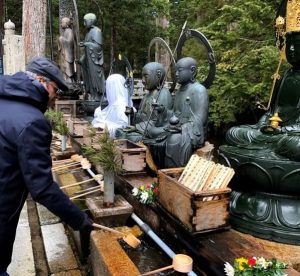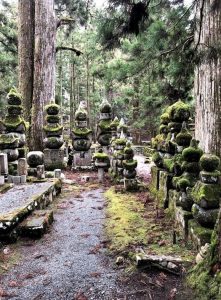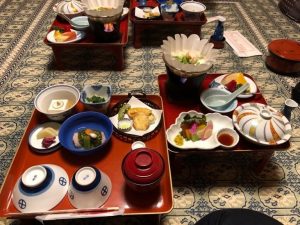Reading Time: 13 minutes
It is essential to that vision of otherness that it must take a long time to reach some places.
You fall into a different rhythm when you get there, in that quiet remoteness away from the noise and trappings of the new and the modern and go deep within to touch the innermost you.
Remote and idyllic, with each mile gone by, modernity seems to fade, and I feel closer to the old, the wild and the primal. Discovering and exploring something new, I begin to feel as if I had stepped out of the life I had always known into some unchartered territory of experience.
Japanese cool has, for decades now, been associated with everything fast, hi-tech, and noisy – the TVs on taxi dashboards, the control-panels on toilets, the underground buzzing worlds around major train stations. But if you wish to experience a deep and ancient Japanese aesthetic and simplicity, you will find it as beautifully in Naoshima and Koyasan as in any temple or Zen Garden.
These places, “take you back to the principles of spareness, simplicity and concentration that graced the haiku, brush-and-ink paintings and Noh dramas of old.” Where technology makes you speed, be up-to-the-minute and all-over-the-place, Naoshima and Koyasan calm and slow you down and are perhaps the two most soul-expanding places in Japan.
Benesse House Museum, Naoshima
What is it like sleeping in a museum at night?
On my way to bed, I walk past an Alberto Giacometti. No guard hovers over Richard Long and Keith Haring. The only sound in the galleries are my footsteps tapping on the concrete floor echoing through the cavernous space. This is the essential appeal of the Benesse’s unusual hotel-within-a-museum: an exhilarating intimacy with art.




From the exterior, the Benesse Museum Hotel looks like something right out of a Bond movie. And sure enough it turns out that You Only Live Twice was filmed here. Inside, there is a lot of white: light woods, and neutral tones, minimalist architectural style that emphasizes the use of simple geometric forms and clean lines, as well as the use of natural light, water, and other natural elements.

 As Tadao Ando says, “The creation of space in architecture is simply the condensation and purification of the power of light”.
As Tadao Ando says, “The creation of space in architecture is simply the condensation and purification of the power of light”.
Accessibility to art is not uncommon on Naoshima, where thanks in large part to a corporate benefactor, a kind of coming together has been taking place over the past two decades, as museums, art installations, cutting-edge architecture, and nature blend in astounding ways making this sleepy island an unlikely destination for globetrotting art pilgrims. In addition to traditional gallery spaces, the Museum’s artworks are also displayed throughout the entire complex including in the bedrooms.




There are nearly twenty art pieces located on the lawns and beaches around the Benesse House, including the iconic Yayoi Kusama pumpkin, perhaps one of the most visited art pieces ever.


Tado Ando’s sleek structure, a six-room hilltop annex called the Oval, where we stayed, opened in 1995, and is one of the four of the museum’s lodging options. Standing on a hill and reached by monorail from the museum, this space has just six guestrooms, fusing Setouchi’s natural beauty with Ando’s architecture. Vast floor-to-ceiling windows in the guestroom offer a sweeping view of the Inland Sea, and the wall of our bedroom is decorated with drawings by famous artists. This spare space has a dramatic black oval pool, and blends seamlessly into the natural surroundings, with tumbling waterfalls and a grassy rooftop lawn making it a unique and peaceful place to stay.


There is a rooftop café; and a restaurant, Issen, on the ground floor of Benesse House Museum, with large windows framing the Seto Inland Sea. Two large Andy Warhol ‘Flowers’ and Hiroshi Sugimoto’s ‘Time Exposed’, grace the walls. The dinner focuses on Kaiseki cuisine made with fresh and local ingredients.


Naoshima is a famous rural art hub, and the Art House Project has placed contemporary artworks inside old wooden houses, scattered across shrines and rice fields, in the 16th century fisherman’s village of Honmura.
The corridors are full of original contemporary canvasses and eerie light sculptures projecting classic Japanese landscapes through the near-dark. In the Ando designed Chichu Art Museum, are five major pieces – a set of Monet water lilies, a large chamber with a reflecting six feet granite sphere at its centre by the American land artist Walter de Maria, and three light installations by James Turrell. In one of the pieces – Open Field – we walk into a room flooded with an unearthly orange light. We climb some steps, and enter a large room suffused in soothingly deep blue light. As we turn around, the people in the room behind look like artworks. A ten-minute walk from the Chichu, takes us to a tall, grey, windowless Ando construction in a field. Here, the Korean-born Lee Ufan, reveals his artistic flair and genius. A single rock placed in front of a great earth-coloured slab, with a light shining on it, looks like a moving representation of a figure praying. Walking back from there towards Benesse House, we passed eighty-eight Buddhas along the side of the road made from industrial waste. Yayoi Kusuma’s “Narcissus Garden,” spreading indoors and outdoors holds us rapt… Contrasts collide as dynamic landscapes, sleek concrete structures and evocative artworks share the same space. Benesse Art Site Naoshima is an immersive art adventure like no other that I have experienced.




Mount Koyasan
Just two hours from the neon-bright bustle of contemporary Japan lies Koyasan, the birthplace of Shingon Buddhism and a place of such mysterious, otherworldly power that it feels like visiting a spirit land.
We step out of our train at Gokurakubashi, ‘The Bridge of Heaven’ and get into a clanky cable car that slowly climbs up a thickly forested slope of pines and step out on a silent country road, that meanders into a settlement consisting of 117 temples, with slate grey roofs. This is the single most powerful spot, the holiest place in Japan – Koyasan, with fifty thousand cultural and historical treasures nestling among the tall cedars and cypress trees. Mount Koya is a testament to everything old and changeless and hushed. There are no convenience stores or pachinko parlours, no karaoke joints around the sacred slopes. For over a thousand years, women were not permitted to ascend the holy mountain. When the mother of the mountain’s discoverer, and the founder of Shingon Buddhism Kobo Daishi, tried to climb the slopes, she was repelled by a “thunderstorm of fire rain.” Here there is nothing but trees, the outlines of temples, and some walking trails. There is the Ichi-no-hashi Bridge, where monks and pilgrims traditionally wash their hands and faces before entering what they believe to be the “pure land,” or paradise, of Shingon Buddhism.

Across that bridge is a dense grove of giant cedar trees, many of them eight hundred years old, surrounded by more than 200,000 graves. And at the very end of the path lies the mausoleum of Kobo Daishi, the “mother of Japanese culture,” and his story “is one that still shivers on the edge of folktale or creation myth.” You come to Koyasan to experience an otherworldly spirituality and to see Okunoin, the passage through the graveyard, the largest in Japan and the site of the mausoleum of Kobo Daishi. The space is filled with thousands of Jizo statues, moss-covered torii gates, and memorials that have been constructed for royalty and monks alike. Daimyo and samurai, kabuki actor and soldier, are all buried here: On one side is the grave of the legendary fighter Toyotomi Hideyoshi on another is the monument where his famous predecessor Oda Nobunaga.


IThe gorgeous Torodo Hall has ten thousand lamps, their flames flickering eternally, which we were gently asked not to photograph. We watched the robed monks carry breakfast and lunch, as they do every day, to Kobo Dashi, who is believed to be sitting in eternal meditation for 1,172 years.


We stay in a temple, The Ekoin. With its history of over 1,200 years, it is one of the fifty-three that offers shukubo, or temple lodgings. Shoes are left outside, and we wear socks or getas and tour our lodgings with a monk who explains the different aspects of Shingon monastic life. Staying here is nothing like staying in a ryokan – there are customs to follow, and the feeling of reverence imbues everything we do. The rooms are minimalistic but beautiful in a way only a Japanese aesthetic can achieve. Tatami flooring and futons furnish the rooms and a tokonoma displays a scroll. Fragrant incense wafts around us.


Here you become one with nature and connect more deeply with yourself. Tall glass windows look out on a courtyard filled with green shrubs and old trees gently tap on the windows with their branches. A shoji screen opens into a veranda where one feels as if cocooned in a forest. When we checked in, I was asked if I would write pages from the Heart Sutra. “It is not calligraphy or art but a sacred ritual and has to be approached as such” I was told. Taking the papers with pale printed kanji characters and a calligraphy brush I sat at the low table in my room and in complete silence painstakingly drew over the letters. You cannot leave it half done and must complete the passage in one sitting. Monks then burn it as an offering to Buddha when guests leave. This practice of Shakyo is one of the deepest meditative and spiritual experiences I have ever had.

Dinner is early and is a traditional Buddhist meal served in quintessentially Japanese lacquer bowls, a delicious meal without meat and fish, garlic and onions: the local specialty, sesame tofu, mountain vegetables and sweet-and-sour seaweed in vinegar sauce make it a feast for the senses. This vegetarian monastery food, Shojin Ryori, very aptly means “to progress to the spirit.”

As the first light filters in we witness a fire ceremony and listen to morning chants. In a ceremony called Goma (which sounds much like our Hindu Homa and seems to have a deep connection with it) monks burn 108 pieces of wood (108 being a sacred number in Buddhism) and scatter white sesame seeds on top of them. It is believed that by doing this all their illusions are purged and replaced with spots of enlightenment, bringing the Buddha into their bodies. Every morning, this holy fire is lit to cleanse participants both spiritually and psychologically and to destroy negative energies and harmful desires. During the ritual, the fire is slowly built until it reaches its peak where it roars loudly to the sounds of a beating taiko drum and the chanting of the priests. Shoko, or incense, meant to cleanse and purify is added to the fire. Wooden sticks called Soegomagi on which you write your requests and petition the gods add to the growing flames. As the air fills with incense and smoke, it is easy to fall into a sort of trance, completely absorbed in the moment.
Koyasan pulses with power; spirits of ancient Japan seem to be all around you. Silent streets with white-clad pilgrims, walk from temple to temple wearing conical hats shaking bells. Describing it, that wizard with words Pico Iyer says, “If ever we are to find a better world, I thought, it has to be right here, right now. Not just in the midst of real life, but, most of all, in the face of death.”
“Wild is magical, mysterious and mythical. Wild has silence and it wipes all the bad noises out of the heart. Real freedom lies in the great, wild somewhere.” Being in the jungle, captures a feeling of belonging to the natural world. No one can return unchanged, for tigers will forever prowl our memory and great herds throng our imagination.
Ranthambore
“Shh! Wait. Stay in the jeep”, our ranger whispered as he shone the headlights. It was a frosty night, dark and still. In the glow of the light, glimmered the white marble steps of Jogi Mahal. “Tigers are known to wander here and relax on these steps.” He spoke. Disappointingly, that New Year’s Eve night no tiger waited for us!
Ferocious, magnificent, mighty, and royal, lurking silently in the shadows …a flash of stripes, a roar, that perfect feline form hunting its prey, seeing a tiger in its full glory is an experience that lives with you forever. There’s nothing like the feeling of pure awe and amazement when you see a majestic animal in its natural habitat. And it is not just about seeing animals, it is about connecting with the earth and all of its inhabitants
Ranthambore “is the forest primaeval” with its rolling hills, shimmering lakes, dramatic cliffs, lush greenery and wild jungle scrub, old crumbling walls, ruined pavilions, wells, the stunning cliff top Ranthambore Fort, where tigers frequent. Jogi Mahal, once the former hunting grounds of the Maharajas of Jaipur, is today, the guest house of the Forest Department of Rajasthan, and stands witness to the region’s glorious past. It is also home to the second largest banyan tree. Not open to visitors, we were very fortunate to stay in this atmospheric and historical palace on the picturesque Padam Talao’s banks which is home to the gharial. Tigers have been known to wander through the grounds of Jogi Mahal. There is no electricity. In the stillness and silence of freezing cold December nights we sit in the pavilion wrapped in layers of blankets and quilts hugging lanterns for warmth. No fires are allowed as they may drive away leopards, tigers, deer, monkeys who come to quench their thirst, mostly at night. You see and feel the beauty of the wild up close and personal. Being here is like pressing the pause button on life and immersing yourself in the present moment. Time stands still and you are cocooned in the natural world around you.
While rooms were spruced up with furnishings from Anokhi, for the late Prime Minister Rajiv Gandhi’s family holiday, the rest of the property was left untouched. As I unpack, a langur sticks his head around the door. ”Go away,” I suggest. He obliges, and henceforth we keep our doors and windows tightly shut.
Delicious dal batti churma and other Rajasthani delicacies are served for dinner. And breakfast is in the open courtyard where birds fearless and bold sit on our shoulders and hands.
Redolent with adventure and history, a hunting abode amidst true wilderness, Jogi Mahal is the perfect place to see the great power and grace of these big cats. As Valmik Thapar, one of India’s best-known naturalists, writes in ”The Secret Life of Tigers,” ”Ranthambhore is a tiger’s kingdom,”
We get our wish: in the pre-dawn glow, a formidably large tigress and her three cubs saunter across the road in front of our jeep before hurtling off into the shrubs once again.
Sabie Park Hotel
‘All our treehouses are securely constructed, well above ground. Don’t worry, you won’t have a leopard joining you in bed! The animals remain at a safe and comfortable distance.’
At some point, every child dreams of playing out her imaginative tales from the heights of a tree house. Perched high above the ground, surrounded by nature, it is little wonder so many of us have dreamed of some kind of tree-house fantasy as children.
Sleeping out under the stars, surrounded by the amplified sounds of nocturnal animals, and then rising with the sun to see the landscape awaken under the warm dawn light, had to be one of the rawest and most profound experiences of our lives.
Lions Sands Private Game Reserve is a gem that shares the bank of the Sabie River with The Kruger National Park. Luxurious and cradled by the untouched African bush, here the usual din of city life is replaced with bird chirps, rustling bush and the occasional elephant trumpet or lion’s roar in the distance. Considered one of the most romantic hotels in the world, the three stunning tree houses offer an unparalleled experience of the South African bush. We walk past rows of imposing white boulders and across a small drawbridge, to the Kingston Treehouse, a secure and lavish platform under the stars that stands high on stilts. Constructed entirely from wood and glass, with a contemporary décor, a big four-poster bed with draped mosquito nets, a bathroom and shower, the untamed and untainted wilderness lies at our feet. The stillness is punctuated only by animals’ whistles, grunts, and growls. As we sip champagne chilling in a gourmet picnic basket with drinks, snacks for midnight feasts and breakfast, the sun sets. Only the glow of lanterns distracts from the beauty of stars overhead in this electricity-free escape. In this remote landscape, we hear a constant rush of life from the meandering Sabie River, animals, night predators and birds. Elephants visit us later in the evening and we could hear them crunching their way happily through the bush as we enjoyed dinner ‘together’ – theirs, a mixture of branches and leaves, and ours, a three-course dinner. A lion roars at night, an unearthly sound, jolting us awake. The previous evening our ranger had informed us that male lions roar to advertise their presence to would-be interlopers, be they nomads passing through or the neighbouring pride hoping to extend their territory. I think of what Toshiko Mori says, “I thought of natural wonders, because we forget how small we are, and of being able to observe animal life in a habitat without interfering with it.” Nothing is ever quite as exciting as elephants walking past, metres away from you, or hearing a lion breathing nearby while you’re trying to sleep. And no gin and tonic ever tastes as good as it does when you’re sitting in the bush watching the world’s mightiest animals roaming in the twilight.




We head back feeling euphoric, refreshed from technology, having been one with nature and surrounded by a world that doesn’t care about your latest handbag or the with-it lifestyle. We have but one life, one world and let’s explore it. After all, “travel is more than having a destination in mind; it’s discovering a place in your heart you’ve never been before.”








